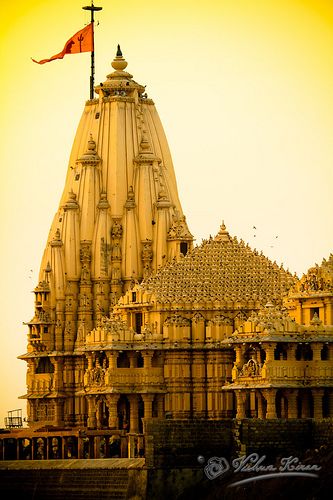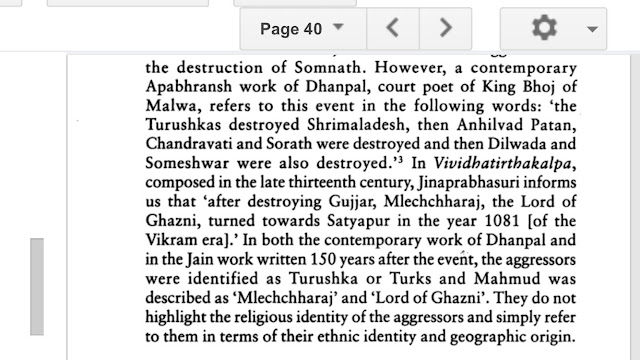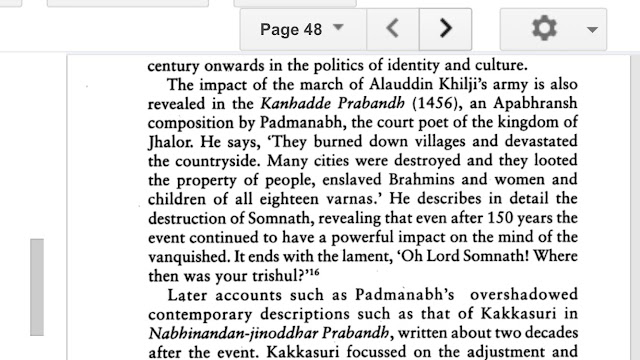सौराष्ट्रे सोमनाथं च श्री शैले मल्लिकार्जुनम्।
उज्जिन्यां महाकालं ओंकारे ममलेश्वरम् ।।
परल्यां वैधनाथं च डाकिन्यां भीमशंकरम् ।
सेतुबन्धे तु रामेशं नागेशं दारूकावने ।।
वाराणस्यां तु विश्वेशं त्र्यम्बकं गौतमी तटे।
हिमालयेतु केदारं घुश्मेशं च शिवालये ।।
एतानिज्योतिरलिगानि सायंप्रातःपठेन्नर:।
सप्तजन्मकृतंपापं स्मरणेनविनश्यति।।
“This temple of Somnath is a symbol of victory of construction over destruction”
In 1951, when India’s first President Dr. When Rajendra Prasad proposed to purify Jyotirling, said
The site of Somnath has been a pilgrimage site from ancient times on account of being a Triveni Sangam (the confluence of three rivers: Kapila, Hiran and Saraswati.
According to mythology, Som is the name of Chandra, who was the son-in-law of Daksha. Once he disregarded Daksha’s orders, due to which Daksha cursed him that his light would fade from day to day.
However, when the other gods asked Daksha to take back his curse, he said that taking a bath in the sea at the origin of river Saraswati could prevent the outbreak of curse. Som worshipped Lord Shiva by bathing in the Arabian Sea at the mouth of Saraswati. Lord Shiva incarnated here and saved him and became famous as Someshvar and Somnath ("the lord of the moon" or "the moon god"), arise from this tradition.
Somnath is a magnificent temple situated in Sagar Kant of Saurashtra in Gujarat state. One of the 12 holy Jyotirlingas of Lord Shiva is in Jyotirlinga here in Somnath. Somnath is also mentioned in Rigveda.
The glory of Somnath-Jyotirlinga located in the holy Prabhas region is deeply explained in Mahabharata, Srimad Bhagavat and Skanda Purana. One name of the moon is “Som“, he did penance here, considering Shiva as his lord. Hence, this Jyotirlinga named as Somnath.
Worshipping in Somnath destroys all the sins and misdeeds of the devotees. One becomes the character of the unending grace of Lord Shiva and Mother Parvati. Therefore, the path of salvation becomes easily accessible to them. All cosmic acts of devotees are automatically successful. Jyotirlinga Shree Somnath Mahadev Temple situated on the banks of Arabian Sea in the west of the Indian subcontinent is unique. This shrine is one of the oldest pilgrimage centres in the country. Also, Somnath temple is mentioned in ancient texts – Skanda Purana, Srimad Bhagavat Gita, Shiva Purana etc. At the same time, the glory of Someshwar Mahadev is also mentioned in the Rigveda.
The temple is divided into three major parts – the Garbh Grih, Sabha mandap and Nritya mandap. It has a 150 feet high peak. The Urn on its peak weighs ten tons and its flag is 27 feet high.
Regarding its uninterrupted sea route – Trishtambha, it is believed that this sea route ends in the South Pole indirectly. It is considered to be amazing proof of our ancient wisdom and understanding.
Also, It is said that this temple is one of the first among twelve Jyotirlingas of Shiva. According to historical sources, the invaders attacked this temple 6 times. Even then, the present existence of this temple is a reflection of its reconstruction efforts and communal harmony.
For the 7th time, this temple was build in the Kailash Maha-Maru style of temple architecture with intricate carvings by Sompuras, a community of stone masons residing in Gujarat and Rajasthan, is situated at Prabhas Patan on the southern coast of Saurashtra, 79 km from Junagadh
Age of war and chaos
This temple of Somnath has been very attractive in front of many destructive foreign invaders who want to lure and convert to the temple glory. Whenever the temple has tried to destroy it, then it has been built again.
Here is oldest visual available of Somnath temple for less-read ppl to see ..
Somnath’s first temple is said to have existed 2000 years ago. Is. In 649 AD, King Maitre of Vallabhi built a second temple in place of the temple and renovated it.
First attack by Al-Junayd In 725, the Arab governor of Sindh is said to have destroyed the second temple as part of his invasions of Gujarat and Rajasthan. Pratihara King Nag Bhatt II constructed the temple for the third time in 815 using a red stone (sandstone) stone.
Second Attack by Mahmud Ghazni in 1026 CE led to death of 30,000 Rajputs defending it & it’s THE ONLY ATTACK by Mahmud Ghazni on Somnath says his biographer ! Temple was probably a wooden structure. Mahmud’s biographers have recorded the attack & his avoiding Rajput Confederacy on way back by taking the Sind route. He was harassed during his retreat & Bhatis Of Jaisalmer ransacked his caravans throughout.
It was rebuilt by Bhim who fled while thirty thousands Rajputs made a Last Stand at Somnath. Contemporary sources generally silent about it, but Dhanapala of Kathamanjari fame speaks of.
Bhadrakali Inscription (1169 CE) records the circumstances in which Somanātha temple was restored by the order of Solanki Rajput King Kumārapāla.
It narrates that seeing the Śiva temple in ruins, the priest 'Bhāva Bṛhaspati' said to the king to repair the temple of Bhagavān. When it said ruins, it doesn't meant that it was completely destroyed. Restoration was obviously done, but the above-mentioned restoration was a big one and hence found special mention.
"This was not mere reconstruction of temple but of whole town." as put by KM Munshi.
Ulugh Khan led the Sultanate armies to Somnath & destroyed it once again during reign of Karna in 1299 CE.
Effects of the fall of Anahilapur Patan, the capital of Gujarat, to the army of Ulugh Khan, the general of Khilji.
जे पद नहीं ज्याग नइ तीरथि, घणइ् दानि त्रैलोकि।
सोमनाथनी चाडि मरंता, ते पुहचता सुरलोकि ।।
Kanhad De Prabandh by Pandit Padmanabh has described attack & resistance offered both at Somnath under united front created by Rajput Chiefs of Vala, Vaja, Jethwa and Chudasama clans & later at Jalore,
where Kanhad Dev & his illustrious son Biram Dev rescued the idol but later in continuous struggle committed Saka, (died to Last Man) !
That is how Kānhaḍade Prabandha describes the last stand of the Rajputs in the defence of Somanātha Temple.
The temple was rebuilt by Mahipala I, the Chudasama Rajput Ruler of Saurashtra in 1308 and the lingam was installed by his son Khengara sometime between 1331 and 1351.
Fourth Attack in 1395 by Zafar Khan, the last Governor of Delhi Sultanate. Also destroyed the temples of Diu & Idar.
Fifth Attack in 1537-54 by Mahmud Begada ( Be= Two, Gadha = Forts) he destroyed the temple at Dwarika & the Jyotirling at Somnath. (A tyrant)
Sixth attack by Aurangzeb at the start of his reign in 1665 & later when he came to know that Puja was being carried out late in his reign he again ordered it to be Demolished completely in 1702. Also ordered demolition of temple at Dwarika too but not sure if the order was carried out !
Aurangzeb's command towards the end of his reign:
"The temple of Somnath was destroyed early in my reign and idol worship put down. It is not known what the state of things there is at the present. If the idolators have again taken to the worship of images at the place, then destroy the temple in such a way that no trace of the building may be left...."
This was taken to mean the conversion of the temple into a mosque.
Historically, Somnath was destroyed 6 times & 7 if we count the 1702 demolition ordered by Aurangzeb when he heard that Puja was being held at the Temple.
Not that fantastical figure of 17 and it was attacked by Islamic invaders, because it was a universally revered Hindu shrine, but each time the Rajput rulers rebuilt it. Funny thing is that when Islamic power had died down all around the world, it was in this period that the Somnath temple could not be rebuilt! There was no unity among Hindu rulers even after a foreign Muslim invader, Nadir Shah of Iran, had shattered the Mughal power in Delhi beyond all hope of recovery in 1739.
The last attack on Somnath Temple was in 1706 but it was as late as 1783 that a small nondescript temple was built at Prabhas Patan by Maharani Ahalya Bai of Indore away from the original site. The linga at Somnath was Swayambhu, emerged on its own from the earth, so the site was all important, but the Maharani could not take it from the Muslims. She was part of the peshwa-led Maratha confederacy which was in league with many Mughal and Pathan (pindaris) chieftains. The proper name is Mughal-peshwa-Maratha-Pindari-French confederacy.....that is the extent to which Shivaji's legacy was ruined.
This alliance attacked Hindu temples at Sringeri and Nathdwara, among many others, but did not touch mosques Like built upon Somnath, other desecrated temples at Kashi, Ayodhya, Mathura, or Bhojshala, were not restored by them as that would mean removing the mosques, which would be offensive to their Mughal overlord and Muslim allies.
Former Mughals in Gujarat had become Nawabs at Cambay, Surat, Balasinor, Palanpur, Radhanpur, and Junagadh, the last three being in Saurashtra, and nothing was done to end their rule. The Rajputs of Saurashtra went about with their wars of expansion without any unity, the Kathis Khumans and Kolis formed marauding bands, only adding to the chaos created by Mughals, Marathas, and Pathans for whom plundering was a way of life.
The Somnath Temple as photographed by D.H. Sykes in 1869.
It was only with the imposition of British rule that war and chaos ended, mercenary armies were disbanded, and a time of peace dawned. Both the Maratha state of Baroda and the Pathan state of Junagadh were freed from the domination of mercenary Arab troops, while the Mughal Nawab of Surat was removed and the city finally freed from the medieval rule by the British.
Prabhas Patan had changed hands many times between the Junagadh Nawab, the Rana of Porbandar, the Shaikh of Mangrol, and then back under Junagadh. Ahalya Bai's small temple took five years to build. In that time the Shaikh of Mangrol held the coastal town, losing it to Junagadh in 1788. The Brahmin Dewan of Junagadh built the Pragteshwara Mahadeva temple. Other Hindu Rajput rulers built or repaired old temples like Kamnath Mahadev and Kedareshwar temple on the outskirts of Patan which has inscriptions of Gohil and Jethwa Rajput rulers.
Somnath under British rule, Junagadh Nawab, and KM Munshi
It is thanks to observant British officers and writers that a true picture of what had happened to the Somnath temple emerged.
This sketch by a British captain in 1850 shows the state of the 150 year old mosque elements (dome and minarets) piled clumsily on top of the ancient temple by Aurangzeb's forces. The photo below was presented to the Viceroy by Nawab Rasulkhanji of Junagadh in 1900, showing the minarets having crumbled away fifty years later.
The mosque had been abandoned because Prabhas Patan was not an important town for the Mughals, and it already had mosques for local Muslims. There is no particular sanctity attached to a mosque and it can be abandoned at any time. Even in the capital Junagadh, the Uparkot Masjid built by the Sultans of Gujarat, was not used by the Nawabs and consequently fell into ruins. Following the British practice, every princely state had an archaeology department. In Junagadh it preserved ancient sites like Girnar and the Uparkot Masjid. But nothing was done for the revered site of Somnath. Neither the temple, or the mosque on top, or the surrounding ruins.
The famous Gujarati author and statesman, KM Munshi, visited Somnath in 1922 and attests to its abandoned state: "Since 1910, I have dreamt and thought and written about Gujarat - one and indivisible rising again in its pristine glory. In my first novel in 1915, I had found in 'Jai Somanatha' Gujarat's ancient battle cry. But at the plight of this shrine, I broke down." Another noted personality that visited Somnath temple was Swami Vivekananda. KM Munshi had resigned from the Congress in 1941 and started the Akhand Hindustan movement, proposing to defeat the Muslim League's demand for Pakistan with violence. He later joined the Swatantra Party and was a founder member of the VHP.
KM Munshi regarded India's Muslims as primarily descendants of Hindus, and for him the reconstruction of the Somnath temple was a joint task for all communities in India. An economic liberal, Munshi opposed the leftist policies of Nehru and considered Sardar Patel as cast in the heroic mould of Prithviraj Chauhan and MahaRana Pratap. In the reconstruction of Somnath temple, Munshi and Patel were aided by the determination of several rulers of Saurashtra, particularly Nawanagar.
Maharaja Jam Saheb Digvijaysinhji Jadeja of Nawanagar and the liberation of Junagadh
The most famous of the Jadeja Rajput rulers of Nawanagar was the cricketer Ranjitsinhji, but his nephew Digvijaysinhji was also no mean cricketer. He served in the Indian Army, headed the Chamber of Princes, and became famous in Poland for his help to Polish refugees during World War II. In 1947 it was clear that the princes of Saurashtra would accede to India, but when the Muslim League politician Shah Nawaz Bhutto became Diwan of Junagadh he pressured the Nawab and roused the Muslims of Junagadh.
The Nawab acceded to Pakistan and all kinds of wild rumors filled the populace: that any day now the army and navy of Pakistan would enter Junagadh, and India would do nothing. Violence broke out in the state and Jam Saheb Digvijaysinhji went to Delhi and warned that there could be retaliation in the Hindu states unless India took steps to end the chaos.
But after rousing Muslims in Junagadh to communal violence, Pakistan did absolutely nothing for them. Under Dewan Bhutto's orders Muslim landlords oppressed villagers, Junagadh army was deployed to crush protests and attack smaller states near Junagadh that had joined India. The peoples government of Junagadh was formed at Rajkot, with Samaldas Gandhi at its head. Hindu landlords like Amra Bhan Wala of Vaghania (Barwala), Ranjitsinhji of Limbuda, and Chandrasinhji Jadeja of Bhadwa-Taluka, led a volunteer force of Kathis and Rajputs against the Pakistani Dewan.
India had created a Kathiwar Defence Force to prevent the conflagration from spreading outside Junagadh. To this were added the state forces of Nawanagar, Bhavnagar, and Porbandar. With no help coming from Pakistan, the Nawab realised he had been duped and fled to Karachi, while the tough talking Bhutto quietly invited India to take control of the state.
India's Home Minister Sardar Patel visited Junagadh in the Nawanagar aircraft with KM Munshi and NV Gadgil. He was visibly moved to see the dilapidated condition of the Somnath temple. After consulting Digvijaysinhji, he took seawater in his hand and pledged that this ancient and sacred temple would be reconstructed and restored to its former glory.
NV Gadgil writes: "Then we two and the Jam Saheb came to the temple and there in the presence of about 500 People, I announced: Government of India have decided to re-build this temple and install the deity. This Government has come to fulfil and not to destroy. The age of reconstruction is now on."
The Jam Saheb gave the first donation of one lakh of rupees for the reconstruction and became the Chairman of the Somnath Trust. Samaldas Gandhi representing the Junagadh administration followed with Rs. 51,000 and became a member of the Trust along with NV Gadgil and KM Munshi. The objects of the Trust were to include not only the rebuilding and the maintenance of the Somanath Temple but also the renovation of Dehotsarga where Bhagwan Krishna was cremated, and numerous Sanskrit pathshalas and goshalas at Prabhas Patan.
Digvijaysinhji Ranjitsinhji became the first Rajpramukh of united Saurashtra state with the capital at Rajkot. The Jam Saheb asked Indian diplomats to send a pinch of soil, a few drops of water and twigs from all over the world for the foundation ceremony of the new temple. The foundation stone was laid, and the flag hoisting ceremony was performed by Digvijaysinhji on 8th May 1950. The Pratishthapan Vidhi was performed by President Rajendra Prasad, on 11th May 1951, and the temple was completed on November 28, 1966. The temple architect Padmashri Prabhashanker Sompura utilized the same local hard stone for the construction as in the older temples.
The Maharaja Jam Saheb remained Chairman of the Somnath Trust till his death. This photo by Dr VS Chouhan on Panoramio shows the Shri Digvijay Dwar, the entrance to the Somnath temple complex, built in memory of the Rajput ruler.
The foundation stone was laid by KM Munshi in 1966 and Digvijaysinhji's widow, Rajmata Gulab Kunwar Ba of Nawanagar, completed this grand entrance gate in 1970 using the same materials and in the same design as the main temple. Just in front of Digvijay Dwar is statue of Sardar Patel. His role in Somnath temple reconstruction is widely known but the contribution of Digvijaysinhji bapu and KM Munshi should be known.The remnants of the old temple, representing the ancient heritage of Saurashtra and Gujarat, have been preserved and are on display at the Prabhas Patan museum.



































No comments:
Post a Comment